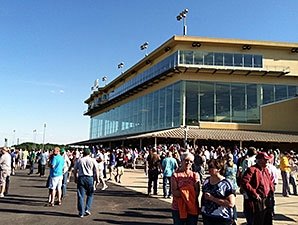PA Report: Slots Provide Almost 90% of Purses


More than $228 million was accrued for purses at six Pennsylvania racetracks in 2015 with 89.6% of the funds derived from slot machine revenue, according to an annual report that analyzes the racetrack gaming industry in the state.
The Pennsylvania Gaming Control Board, in a benchmark report released April 19, said slots at casinos in the state generated $204.1 million for purses, while pari-mutuel handle produced $24.1 million for purses, or 10.5% of the total, which is for Thoroughbred and Standardbred racing combined.
Pennsylvania has three Thoroughbred and three harness tracks, all of which have full casino gambling. The Race Horse Development Fund in 2015 earned roughly 11% of gross slots revenue, according to PGCB statistics.
About $246 million was deposited in the RHDF last year, up 1.5% from $242,331 in 2014. Purses paid totaled $193.6 million; the Thoroughbred breed development program received $20.2 million, while the Standardbred breed development program got $17.6 million; and health and pension benefits for horsemen totaled $11.1 million.
"An uptick in 2015 in the amount of slot machine revenue generated by casinos over the previous year led to a distribution of nearly $3.8 million more to the Race Horse Development Fund," said Kevin Kile, director of the Office of Racetrack Gaming for the PGCB. "This revenue, combined with more than $65 million in backstretch improvements since 2006, has provided enhanced conditions for personnel who work and reside in and around the stable and backside areas of the racetracks."
The Pennsylvania Race Horse Development and Gaming Act of 2004 required existing racetrack casinos to each invest $5 million in racing-related capital improvements over the first five years of operation, and $250,000 in each of the next five years. Parx Racing spent the most money by far—more than $28 million the past five years—to build 31 barns, install a new safety rail, and upgrade the paddock, according to the PGCB report.
As for pari-mutuel handle, the report notes that on-track handle on live races at the six tracks totaled $30.6 million last year, down from $38.2 million in 2011. Handle at off-track wagering facilities—at least six have closed over the past five years—was $8.4 million, down from $15 million five years ago.
Out-of-state wagering on live races in Pennsylvania totaled $650.2 million in 2015, up from $594.1 million in 2011 but down from $719,538 in 2013.
The PGCB report notes that average daily gross slots revenue was 13% higher when there was live racing at the six facilities, but it notes "this does not take other factors into consideration such as peak times when racing is scheduled or casino-related promotions that may be taking place at the same time."
The report also calls live horse racing an amenity "that enhances the overall entertainment experience that attracts patrons to the property who would not otherwise visit the casinos."
